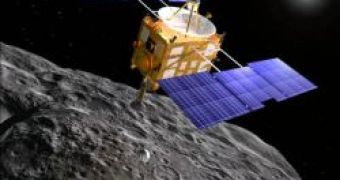The Japanese Space Agency, JAXA, has announced today that it has succeeded to reestablish communications, damaged after the November 26 landing, with the Hayabusa probe, but that the launch of the metal pellet for collecting a sample of the asteroid might have failed.
"The explorer is still alive, but the communication function was seriously damaged. It is almost a miracle that it functions at all," Project Manager Junichiro Kawaguchi said.
The data sent by Hayabusa after the communication system was operational did not suggest that the metal pellet was fired as researchers initially believed, an agency representative said.
"Now we just won't know till Hayabusa comes back to Earth, and we open it up," he said.
The asteroid's exploration process should have started with the launch of the robotic lander MINERVA (MIcro/Nano Experimental Robot Vehicle for Asteroid), fitted with the six CCD sensors and six thermal sensors, but when it was released, the engineers lost contact with it and it was lost.
The next step was landing Hayabusa on Itokawa, a world first. During the first attempt, the landing was successful, but the metal pellet could not be fired, which forced the engineers to attempt a second landing.
Although it had sustained damage to one of the thrusters, it was initially thought that the second attempt to collect a sample was successful, one of the spokespersons saying that "the process of sampling also seems to have gone very well."
Hayabusa was launched on May 2003 and it has until December to orbit the asteroid. After that, it will have to embark on the 290 million kilometer trip to Earth. The probe is scheduled to land in Australia on June 2007.

 14 DAY TRIAL //
14 DAY TRIAL //